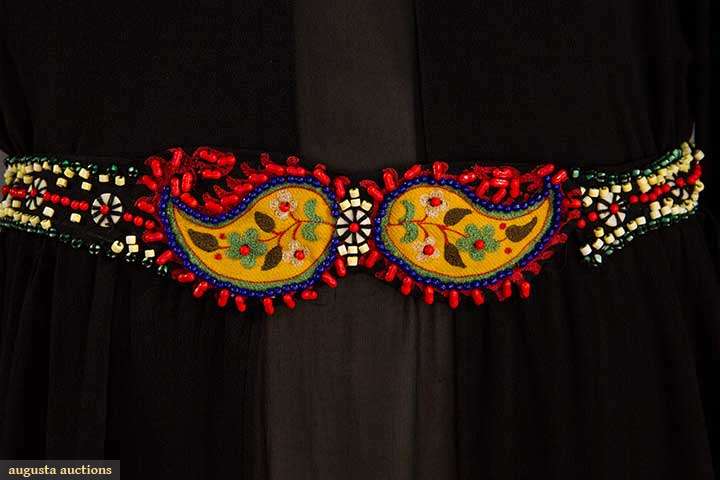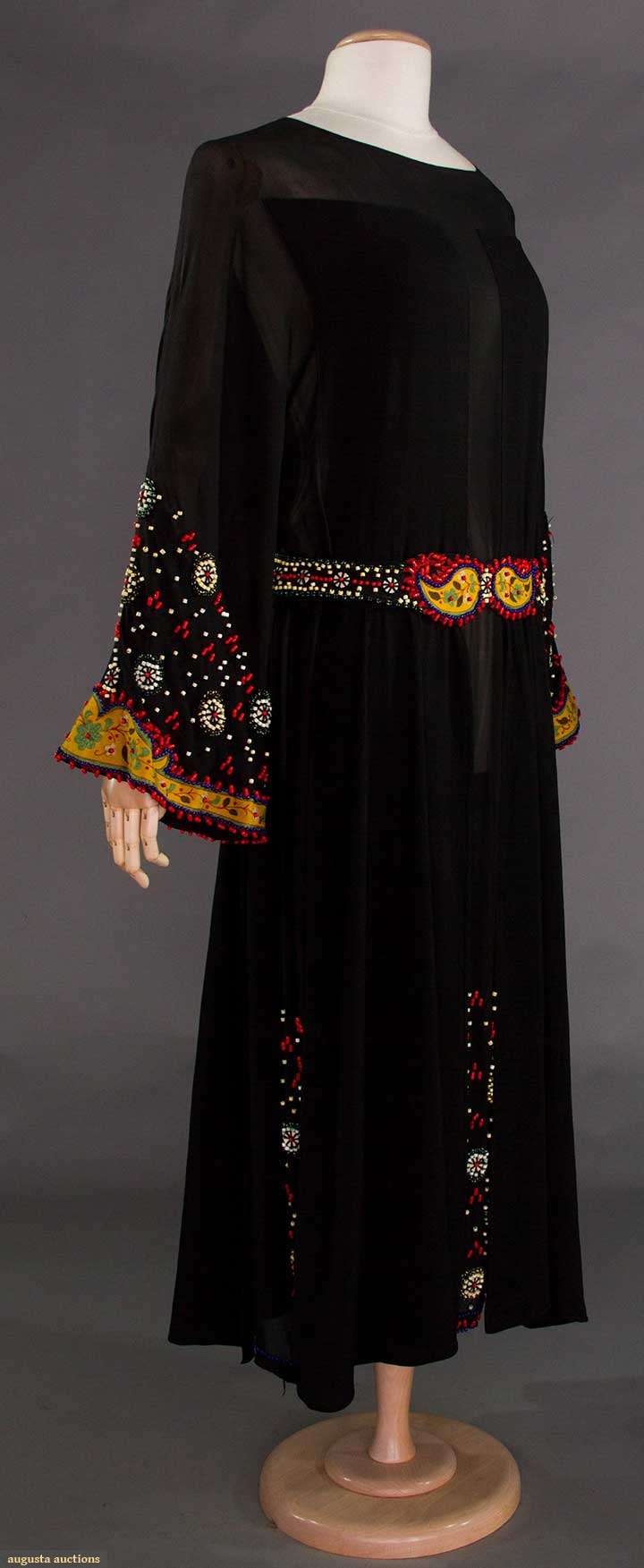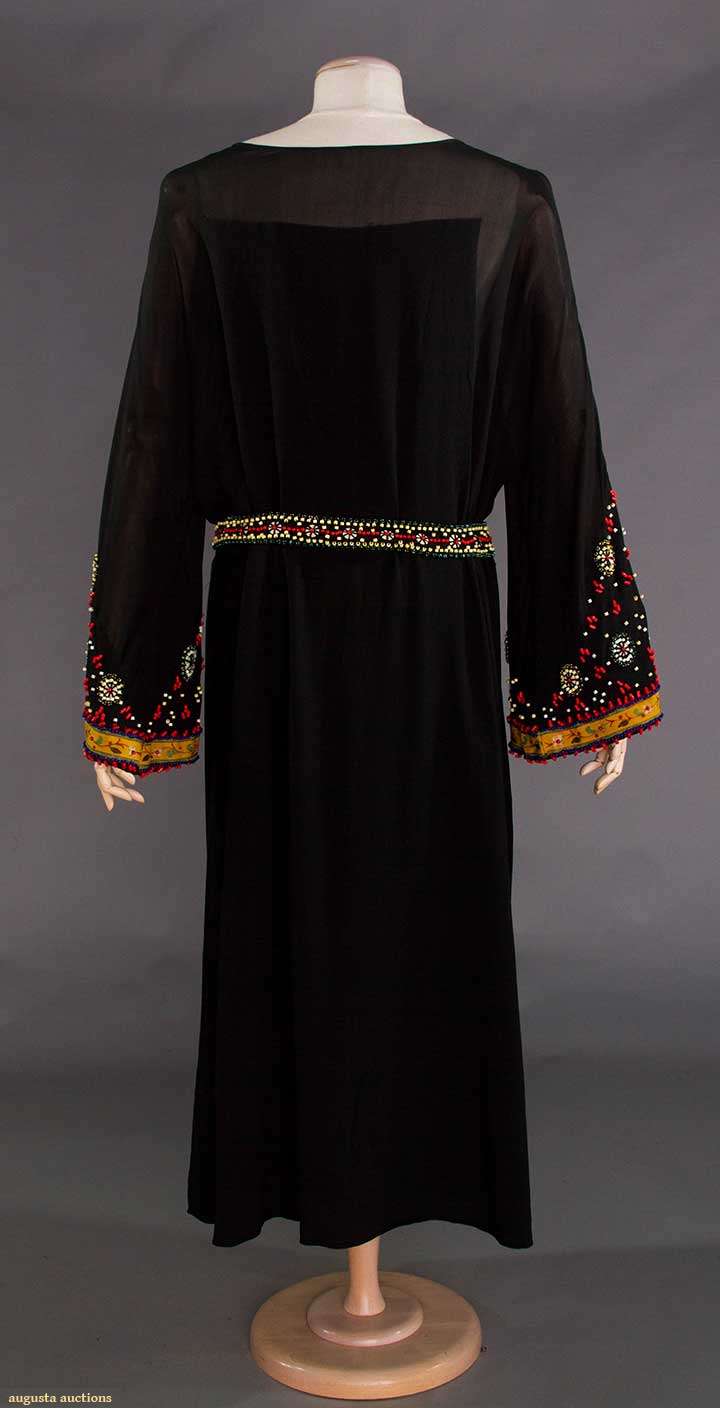This week’s Rate the Dress pick, a beaded paisley 1920s number by Patou, continues on the 1900-1924 Edwardian & the Great War #greatwarmarch theme, carried over from Instagram.
If you’re on IG you can join us by sharing anything relevant to the daily theme from between 1900-1924 and tagging @wearinghistory and I (@thedreamstress)
Last week: a late Edwardian dress in pink velvet and lace
Reactions to last week’s Rate the Dress were quite simple. They came in two varieties: #1 “I love it!” (average rating: 10) and #2 “I’m not sure about all those materials and elements together” (average rating 7).
The Total: 9.2 out of 10
Clearly the loves outweighted the unsures!
This week:
While I picked this dress because I was looking for something ’20s that was a nice contrast to last week’s pink & lace number, this dress is also a fascinating counterpoint to the the 1810s beaded dress from two weeks ago:
Both dresses feature a simple cut enlivened by vivid embroidery: the 1810s on Empire white, this on ’20s black.
Both dresses shared a mix of beading and embroidery, and in both cases the embellishment owed some inspiration to Indian and Kashmiri design. The 1810s dress subtly replicated the motifs on ca. 1800s Kashmiri design, and this dress includes an explicitly paisley/boteh motif at the centre of the belt.
Like the 1810s dress, this is very much a frock of its own time, owning its colour to the growing fashion for black as the ultimate chic hue, and its shape to the growing trendiness of peasant inspired garments.
The black faille panelling on slightly sheer chiffon is another extremely ’20s touch: lending a hint of sex appeal to an otherwise modest frock.
Now, of course, we come to the important part. The rating. How will Patou’s frock rate in comparison to last week’s dress, and the white 1810s of a fortnight ago?
Rate the Dress on a Scale of 1 to 10
(as usual, nothing more complicated than a .5. I also hugely appreciate it if you only do one rating, and set it on a line at the very end of your comment, so I can find it! Thanks in advance!)






This dress certainly doesn’t look like a nightgown!
I love the contrast of the bright beading against the otherwise unrelieved black. But I’m not sure about the shape of the beaded sections on the hanging sleeves, and in the skirt. (Love the belt, though!) This is one time where it would help to see the dress on an actual human figure. I’d say this one is not quite a 10, but better than a 6 or 7.
7.5 out of 10.
Like Catherine Raymond I love the color/black contrast, but what prevents me from out-and-out enthusiasm is I feel like the sleeve motifs should be better balanced by the skirt motifs. The skirt motifs strike me as being, to use a favorite Project Runway critique word, “unresolved.” Perhaps the addition of some of the embroidered yellow fabric to them would make a difference.
Love it! 10.
I’m going to differ with Cyranetta on how the hem should be embellished: since the style was meant to elongate and straighten the figure, the designer wouldn’t want to break the skirt up horizontally so close to the ankles. The beaded colors and motifs feel fizzy and popping to me, which is a fine contrast to the basic and blocky cut. They are almost like dancing city lights above a folk/traditional horizon. Can I call it Deco-folko?
It is playful and flirty with underpinnings of sophistication. I love it.
8/10
I also like the bright colours of the beads against the black. The belt is just fantastic and I like the sleeves. I’m not quite sure about the skirt beading. I wish I could see it better. Still, overall it’s lovely.
8/10
I like the drama of the gown, and that it has so much punch while still being relatively understated – and not too confining for its wearer. But I feel like it’s also idealized here – the mannequin can model the gown with the geometry of the sheer panels on full display and not blink an eyelash, both because it lacks eyelashes and because it’s a mannequin – it doesn’t need an underdress. I can’t help thinking that most underdresses, regardless of cut or color, would mess with the simple, straight-lined elegance I’m seeing here. A black dress would muddy everything. A contrasting color, like red or green, would show up, but it might make everything too busy.
So I like it for what it is, but I’m not sure how I’d like it once it was modified and actually worn.
8.5
I’d wear it in a heartbeat. I don’t usually look at these dresses from the point of view of whether I would wear them but sometimes I can’t see past it! I
This is no surprise to you knowing how much black with embroidery I have in my wardrobe already.
10/10
I love 1920’s clothing, the dress is very elegant
10/10
Not a frock I would wear as I’m not a fan of black and the Indian and Kashmiri design doesn’t quite work for me. In my view, the beading and embroidery clash rather than compliment each other. That said, there is a charm about it. The black certainly enhances the embroidery and bead work. I like the shape of the sleeves and the simple lines of the dress overall. I could see this being worn in the 1970’s too. It is always good to see some Patou whatever my feelings are about the gown so thank you for sharing.
6 out of 10 from me.
Groovy! I’ve been pillaging an on-line archive of 1910-1930s fashion magazines and there are many designs that anticipated the flower children of the 1960s and the boho chic of now. This would have fit into my college wardrobe 🙂 or my now wardrobe.
I like the austerity of the underlying dress – it’s the mythical plain black dress – and the beading is vivid but scattered enough to make it a lively accent, not gaudy. Unlike some of the era’s designs, which looked like you mugged a Russian peasant and stole their best clothes, this has Patou’s usual light touch.
With a plain black “costume slip” it’s a bit peek-a-boo but still ladylike. With a skin-toned chemise it could be one of those “what did I see?” dresses that has waiters walking into pillars.
it’s a 10
I think a seven. It wears heavy. In this case the whole doesn’t equal the sum if its parts.
I love it! I can see it going down the runways in the 1970s, and again today. 10/10
I don’t particually like it. Reminds me of 1960s hippy kaftans. didn’t like them then don’t like them now
5/10
So Isadora! 10/ 10!
Wow!
10/10
Not sure I like the yellow bands on the ends of the sleeves. Like Sue Said, the black seams to wear heavy. But them a lot of dresses in that period did.
8/10
The beading is, for the most part, pretty. But the positioning of the paisley motifs on the belt looks just like a yellow mustache. I’m sorry, but now that I have seen it, it cannot be unseen! So points will be docked for the mustache belt. The sleeves are pretty but a bit much.
All in all, 6/10, and that’s more because I like its potential.
(Will you be rating the Oscars again this year?)
Unfortunately, this dress isn’t my favorite. The beading comes off as kitschy instead of elegant like the last beaded dress. My main issue is with the beaded belt, but I’m not too fond on the beading on the skirt either. If the belt and skirt beading were removed, I think the sleeves would be a striking feature compared to the simplicity of the rest of the dress. As is, 5/10.
I love the yellow trim and the beading on the ends of the sleeves but I’m not so fond of the belt. I also like the severe black with the bright beading.
8/10